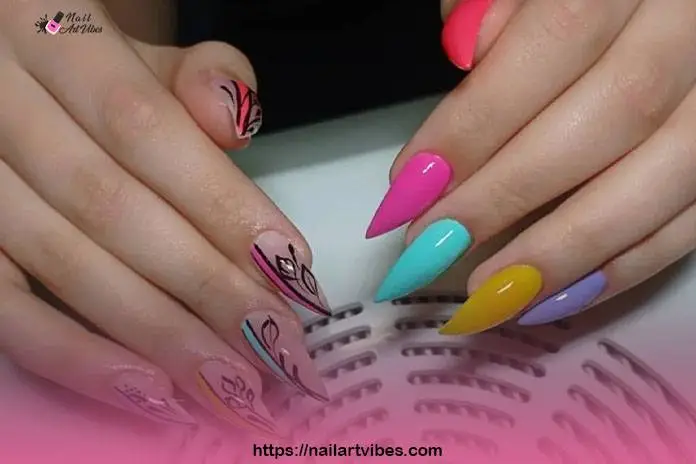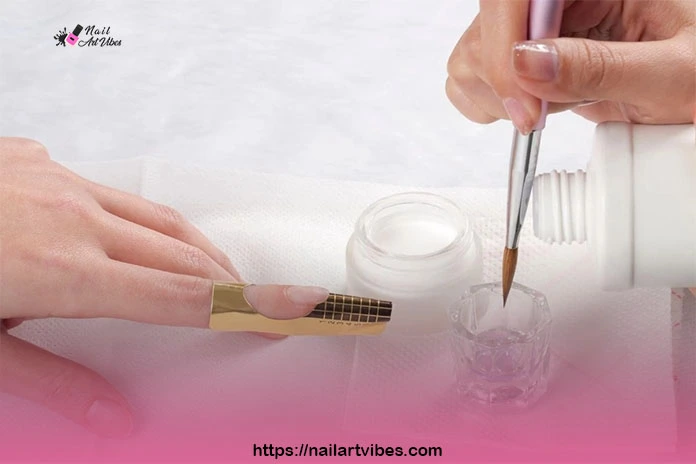Dip Powder Vs Acrylic Nails: Which Is The Better Manicure?

When it comes to nail enhancements, dip powder nails, and acrylic nails are two popular options that many individuals consider.
While both can add beauty and strength to your nails, they have distinct differences in terms of application, durability, and appearance.
In this article, we will delve into the topic of “Acrylic and Dip” and provide you with an in-depth comparison of these two nail enhancement techniques.
Whether you’re a nail enthusiast or someone looking to enhance their nail game, read on to discover which option might be the best fit for you.
Difference Between Dip Powder Nails & Acrylics
Dip Powder Nails: A Closer Look
Dips also known as powder dip powder nails or SNS (Signature Nail Systems), have gained popularity in recent years.
This technique involves applying a bonding agent to the nails, followed by dipping them into a pot of powder.
The process is repeated a few times to build thickness and color. Finally, a sealant or topcoat is applied to secure the powder and add shine. Also, these nails are not like acrylics.
Acrylic Nails: A Closer Look
Acrylic manicures, on the other hand, are created by combining a liquid monomer with a powder polymer to form a dough-like substance.
Nail technicians then shape and mold this substance onto the natural nails or nail tips to lengthen your nails. As the substance dries and hardens, it creates a strong and durable extension that can be shaped and buffed as desired.
These nails tend to be more reliable and can also be adorned with various designs and nail art by pasting them using acrylic nail glue. These nails last longer than other types.
Acrylic vs Dip: Key Differences Explored
1. Application Process
The application process is one of the main points of distinction between dip nails and them.
Dip Nails Application
The application of dips is relatively straightforward and involves fewer steps. As it does not require liquid monomers, there is no strong chemical odor during the application process.
The pigmented powder used in the process plays a real role. The nail technician starts by cleaning and prepping the nails, then applies a base coat to promote adhesion. Next, the nails are dipped into the colored powder so they ensure the dip powder is over the nail entirely, and the excess is brushed off.
This process is repeated, and a sealant is applied to protect and add shine to the nails. Wear these nails if you’re allergic to acrylics.
Acrylics Application
Acrylic manicures involve a more intricate process where the powder and liquid need to be mixed to create a workable dough. The acrylic liquid is interchangeably called liquid monomer as well.
These nails are applied by putting acrylic onto the nails or nail tips, shaping and sculpting them as desired. Working quickly is crucial as it sets and hardens rapidly.
Once the desired shape is achieved, the nails are buffed and polished for a smooth finish and you get your nails done. These nails better adhere with their own glue. If it could be possible, find a healthier alternative to acrylics.
2. Appearance and Thickness
Dip Nails
Powder dip nails provide a natural and glossy finish with beautiful nails like gel. They are often lauded for their ability to enhance the natural beauty of nails without the need for extensions.
The dips come in a variety of colors and shades, allowing for customization. However, dips might not offer the same level of thickness and durability as acrylic nails, especially for those seeking long extensions.
Acrylic Nails
Acrylic manicures, being extensions, offer more versatility in terms of length and shape. These nails are made to achieve various nail shapes, such as square, oval, or stiletto.
Acrylic manicures are known for their sturdiness and ability to withstand everyday wear and tear, making them a popular choice for those seeking durable and long-lasting nail enhancements.
3. Longevity
Dip Nails
Dip nails last longer than 2 weeks, depending on individual nail growth and maintenance. The longevity of a dip manicure can vary based on how well the nails are cared for, the application process, and the brand of products used.
Acrylic Nails
Acrylic manicures can last up to six weeks with proper care and maintenance. However, it’s essential to get infills as your own nails grow to maintain a polished look. Regular infills prevent lifting and ensure the acrylic manicure remains intact and aesthetically pleasing.
4. Maintenance
Dip Manicure
Dips are relatively easy to maintain. You can keep them looking fresh by reapplying the topcoat every few days to maintain the shine and protect the nail color. Additionally, avoid using nails as tools to prevent chipping and lifting.
Acrylic Nails
These nails require regular maintenance, mainly through acrylic powder infills as the natural nails grow. Neglecting to get infills can lead to gaps between the fake and the natural nail, resulting in breakage and lifting. Proper maintenance is essential for preserving the longevity and appearance of acrylic manicures.
5. Strength and Durability
Dip Nails
While dip manicures offer a glossy and natural appearance, they might not be as robust. This makes them more susceptible to chipping, especially for individuals with an active lifestyle or those who frequently use their hands.
Acrylic Nails
These nails are renowned for their strength and durability, making them an ideal choice for those with weak and brittle nails. The strong extensions can withstand daily activities, making them suitable for individuals who desire long and durable nail enhancements.
Pros and Cons of Dip Nails
| Pros | Cons |
|---|---|
| The quick and easy application process | Less durable |
| Natural and glossy finish | Limited color options and designs |
| No strong chemical odor during application | Chipping can occur more easily |
| Suitable for those with healthy nails | The removal process can be time-consuming and damaging |
Pros and Cons of Acrylic Nails
| Pros | Cons |
|---|---|
| Highly durable and the nails can last longer | Strong chemical odor during application |
| Versatile in terms of length and shape | Requires regular infills to maintain the look |
| Strong and sturdy | Potential damage to natural nails if not applied properly |
| Can withstand everyday wear and tear | The more labor-intensive application process |
Frequently Asked Questions (FAQs)
Q: Can I switch between dip & acrylic manicures?
Yes, you can switch between the two. However, it’s essential to give your nails some time to breathe between applications to maintain their health.
Q: Which option is better for nail health?
Both options can be safe for your nails if applied and removed correctly. However, overuse or improper removal of either nail can lead to damage.
Q: Do dips or acrylic nails require UV/LED light for curing?
No session except gel manicure requires UV/LED light for curing. They set and dry naturally. Gel nails are the only ones that need to be cured. Gel polish does not get dried off on its own.
Q: Can I do dips or acrylic nails at home?
While DIY kits are available for both options, it’s advisable to get nails done by a professional nail technician for the best results.
Q: How do I remove dips and acrylic nails safely?
It’s best to have fake nails removed by a professional to avoid damaging your natural nail bed. When you carelessly remove these extensions, it damages your nails.
Conclusion
When choosing between dips and acrylic nails typically consider factors such as your nail health, desired appearance, and maintenance preferences. Dip powder manicures offer a natural and glossy finish with a simple application process, making them a great option for those with healthy nails.
On the other hand, acrylic nails provide durability, versatility, and the ability to create various lengths and shapes.
Whichever option you choose, always prioritize the health of your natural nails and seek professional assistance for application and removal.
Proper maintenance and care will ensure that your nails remain beautiful and strong, no matter which nail enhancement technique you opt for. You may make your nails look more good by adding adornments.
Fake nails directly affect the natural nails underneath. If gorgeous nails get done, be careful if that type is not dangerous to natural nails.






